👕 WTSMerch now available
🎟️ WTSFest 2026 tickets on sale for London, Portland, & Philadelphia
👕 WTSMerch now available
🎟️ WTSFest 2026 tickets on sale for London, Portland, & Philadelphia

Author: Deborah Oyewole
Last updated: 16/10/2024

Just as recipes provide guidance for creating delicious meals, content outlines provide writers with a blueprint for creating compelling content which is aligned with the brand’s values, is compliant with any relevant regulations, and is genuinely helpful for website visitors.
There are a bunch of great paid tools on the market which can help streamline this process, however, creating content outlines when you don’t have access to these sorts of tools can be challenging.
But fear not! In this article, I’ll reveal how to develop comprehensive content outlines, using only free SEO tools.
When there’s no content outline to guide the writing process, the content produced often lacks focus and/or depth. The content may not reflect the brand’s values, and there may be compliance or legal issues with the content created.
As a result, additional rounds of feedback and amendments will likely be needed prior to the content being published.
A detailed outline makes the writer’s job quicker and easier, and they can be confident that the content they are creating is fit for purpose. Preeti Gupta, Founder and SEO at Packted, says:

Failing to create a comprehensive content outline can lead to missed opportunities to rank, compliance issues, and more. Melissa Popps, Content Strategy Director at Rickety Roo, says:
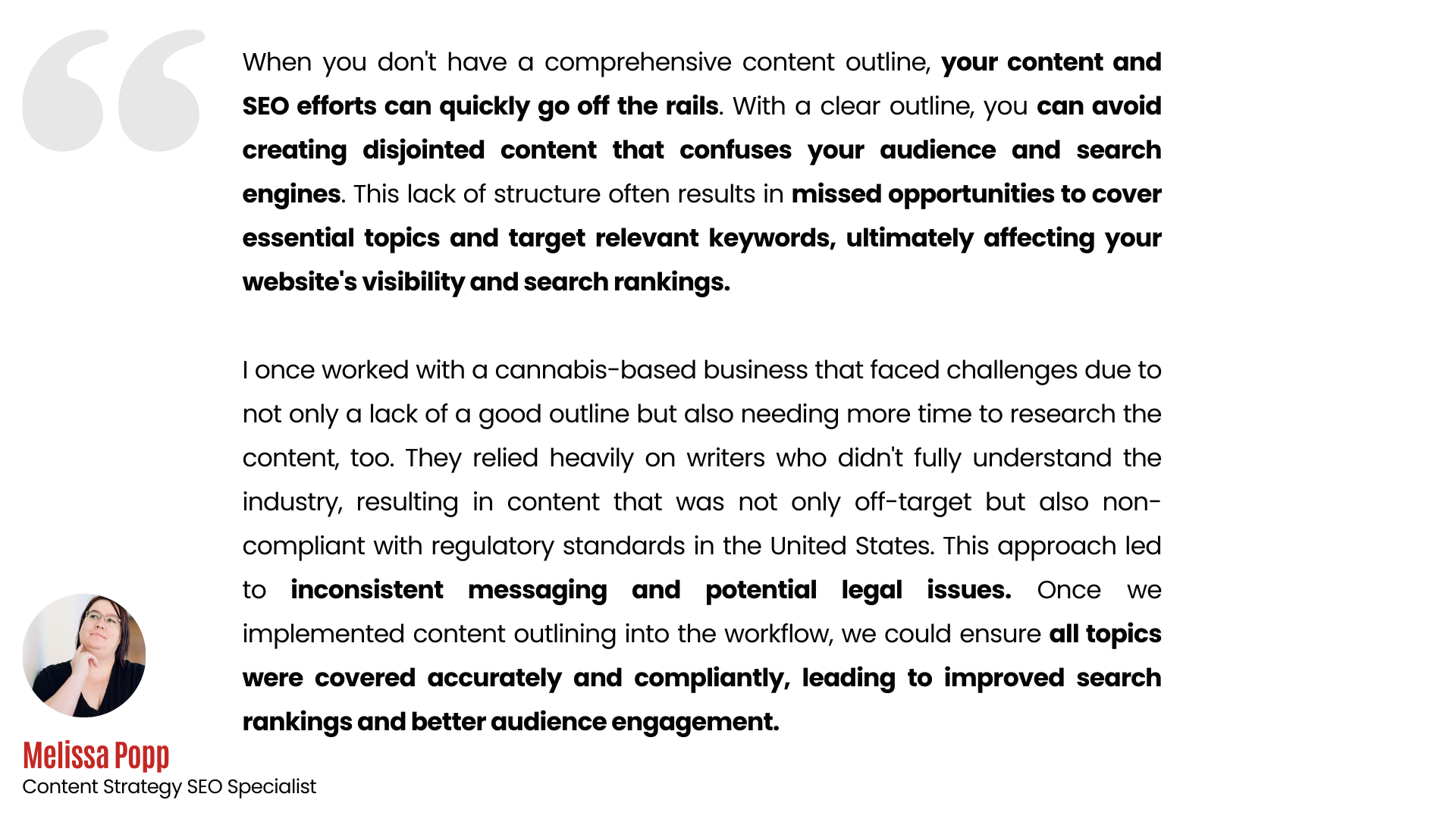
Whether you’re using a paid or free SEO tool for outlining content, there are critical elements your outline should include:
Let’s look at each of these in turn…
I love David Ogilvy’s quote:
“Don’t just create content to get credit for being clever — create content that will be helpful, insightful, or interesting for your TARGET AUDIENCE.”
To understand your audience, it's critical to conduct thorough audience research. This research is a thoughtful questioning journey to understand who you are creating content for.
This is the bedrock of your outlining journey because how you choose to deliver that information (i.e., the style, tone, depth, etc.) depends largely on who your audience is and their goals.
It’s also an important consideration from an SEO perspective; Google, in their helpful content update, explained that:
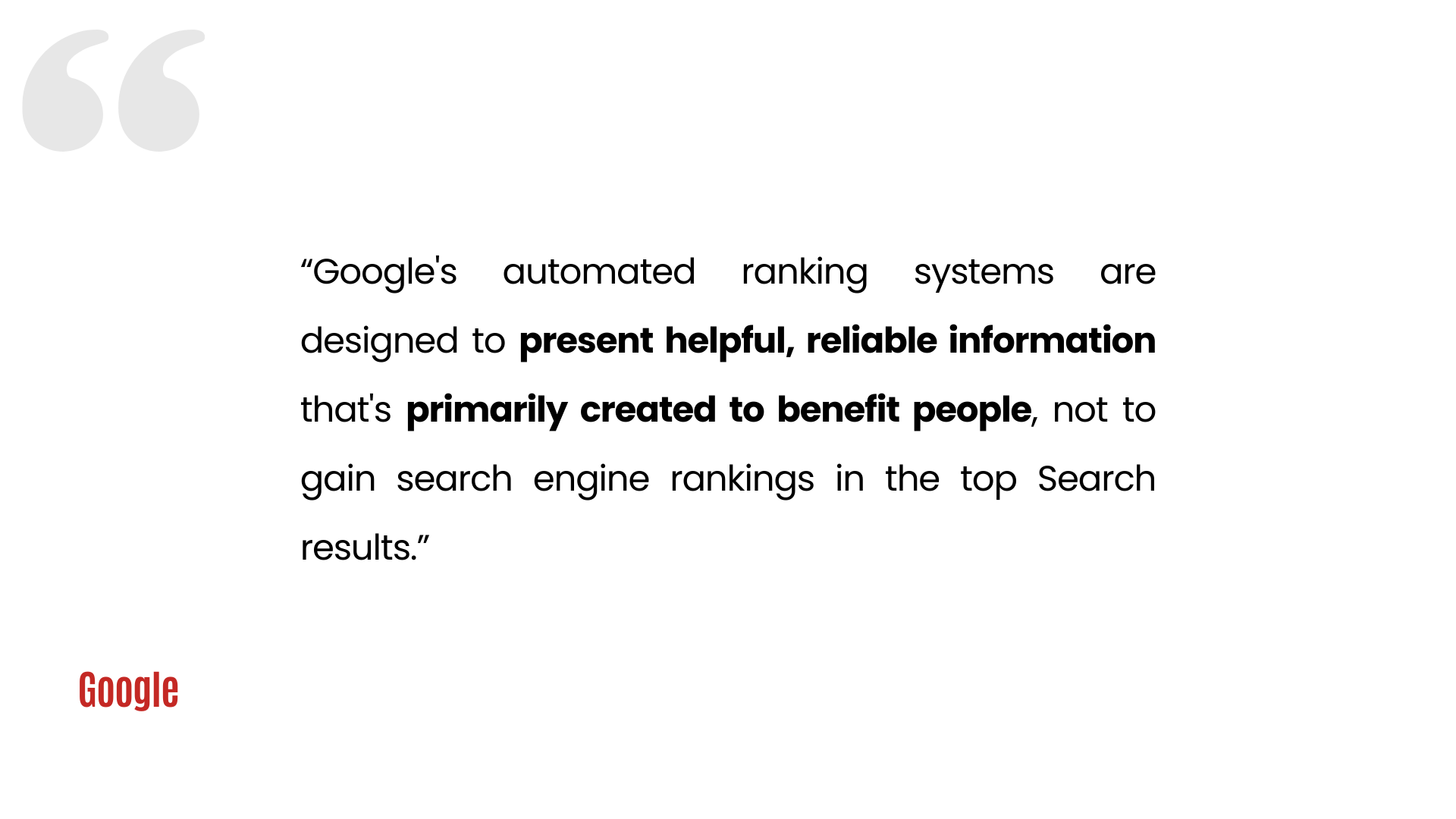
Ensure your target audience section answers the following questions:
Here we’re looking to provide the writer with a deeper understanding of the topic. To do this I like to:
I’ll also include details on:
Whenever someone enters a query into a search engine, they have a goal in mind, and search intent is the reason or goal of a search query. In reality, there are probably hundreds of potential intents, but broadly speaking, they fall into one of the following groups:
If you want to understand the search intent behind any given query, look at the search engine results page (SERP) for that query and see what types of content are served. When you understand what your audience is searching for, you can better outline your content to meet their needs.
Targeting the right keywords starts with keyword research. Keyword research helps you identify specific words and phrases your audience uses when searching on Google or other search engines.
The focus of keyword research includes:
During the keyword research phase, determine the primary, secondary, and tertiary keywords if possible. Generally, primary keywords are the main idea or subject of a topic. Secondary keywords are related terms that add more meaning or context to a primary keyword. They help broaden the scope of your content and target more specific queries.
Semantic keyword selection involves choosing words that have a topical relationship between each other and the overall theme of a page. It’s about adding related terms for more context to your content to help search engines better understand the content on the page and boost the specificity and focus of your topic.
The idea is to:
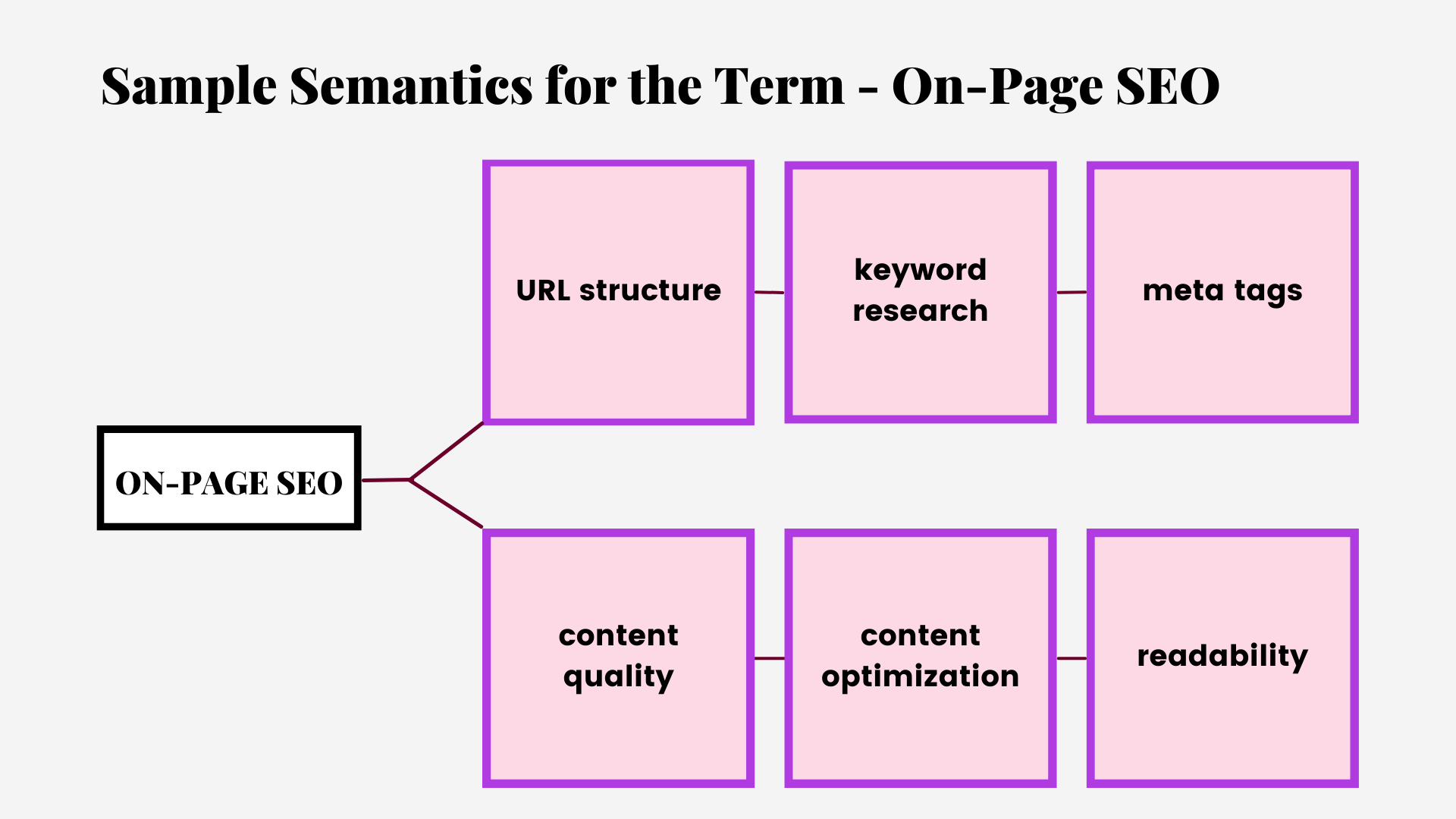
Sample Semantics for the Term - On-Page SEO
Competitor analysis involves investigating, reviewing, and analyzing other websites that have created content on a similar topic. At this stage, you’re trying to understand the content types that search engines reward.
You can do this by analyzing the SERP for top-ranking competitors to understand if a search query is classified as an informational, transactional, commercial, or navigational content type. This will help guide the overall structure of your content, whether it will be an article, product page, landing page, etc.
During competitor analysis, remember to do the following;
It’s important to note that your aim here is to create valuable content, not just to rehash or regurgitate what already exists online.
I love Lily Ugbaja’s ideology about creating quality content. She says:
“Standing out with quality, even if you are creating just one piece of content, carries way more weight than publishing frequency right now because of how easy it is to just publish content.” - Lily Ugbaja
Source: https://seo.thefxck.com/lema-framework/
This statement also aligns with Google’s quality questions about finding a unique angle and ensuring your audience has the best experience.

Source: Google Helpful Content Documentation
The essence of outlining is to ensure proper content planning. So, as we outline, we need to think about the various SEO elements that need to come together to improve user experience. Internal linking is vital at this stage as it enables you to connect the new content with existing content on the website. SEO-wise, it improves website crawlability, and it also helps users to easily find further related content.
Not planning internal linking alongside outlining can lead to the following;
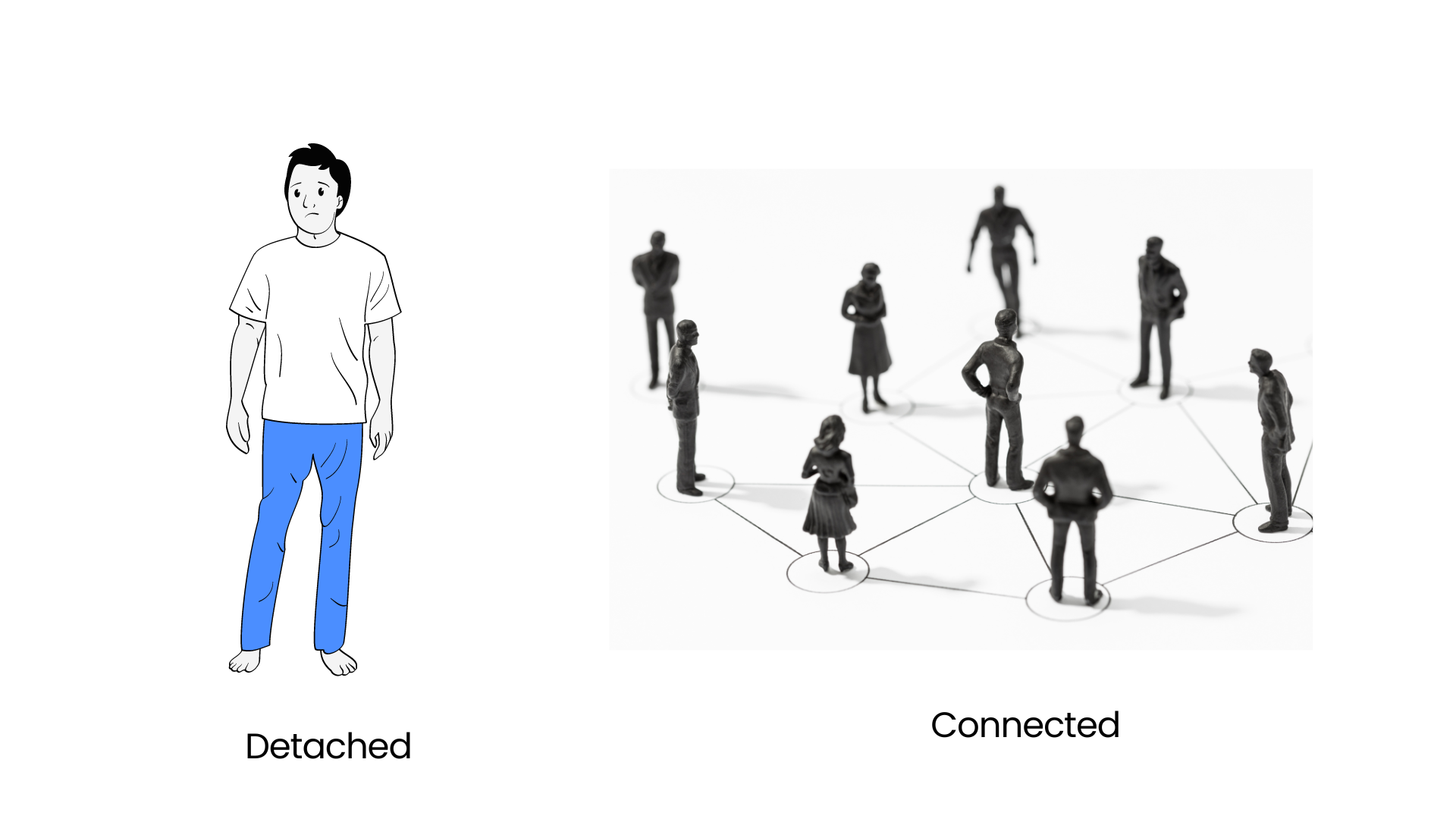
An illustration of an unlinked content and a linked one
At this point, consider which internal pages on the website the content you're outlining should link to, and also consider which existing pages on the website should link to this new content.
During your outlining process, consider which reputable sources you might include links to. Here, I like to consider which sources will add value to the content.
Here are some ways to include links to valuable external resources:
I also like to think about SERP feature opportunities at this point:

Source: Semrush
Check the SERP for your primary keywords to understand which SERP features appear, and in your outline, structure your content to give yourself the best chance of appearing for featured snippets, People Also Ask (PAA), etc.
As you create the outline, think of the type of schema that may add more context to the topic to aid the search engine’s understanding of your page. One of the ways to uncover this opportunity as a beginner is to spy on competitors using Google’s Schema Markup Testing Tools.
Try to understand how competitors are using images for the topic. What type of images could add value to the page?
Once you’ve noted all the image opportunities, remember to mention image optimization practices, including descriptive alt text, relevant image captions, and descriptive file names for all pertinent images used.
This is where you lay out your article using relevant headings.
Based on the SERPs analysis and other critical elements, what article structure would be the best fit? Ensure your content structuring follows content hierarchy starting from H1. Here’s what Google says about headings and titles.
An Illustration of heading structure
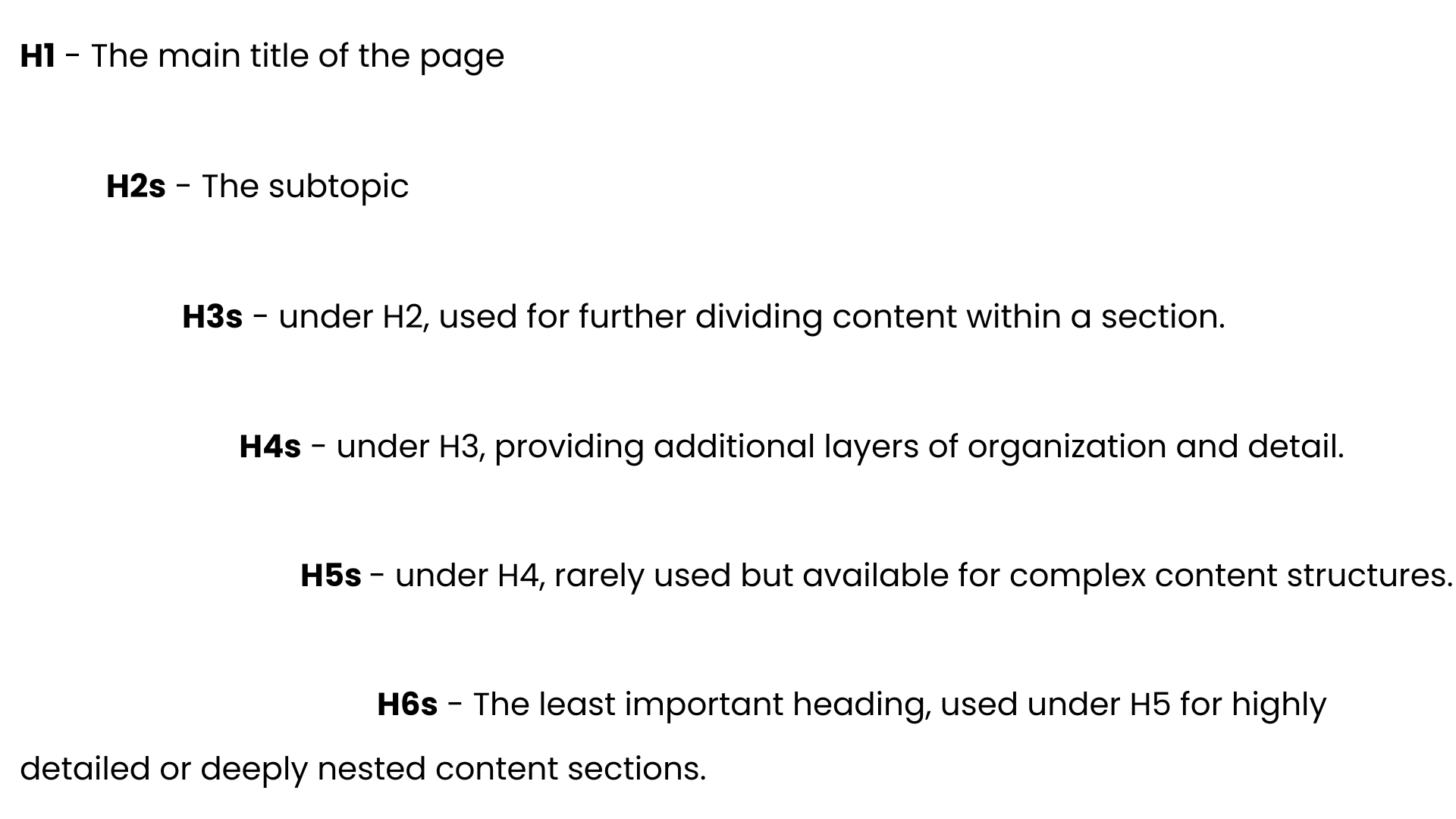
Headings H1 to H6 and their meanings
More tips: Consider the People Also Ask section for questions and ideas to answer in your content. Other places to gather question ideas include Quora, Reddit, Answer the Public, and the company’s customer support team.
Alternatively, you may consider using AI for content outline inspiration.
We’ll be more practical in this section by implementing all we’ve discussed in the previous sections. Let’s get into action with some free tools!
Let’s imagine we’re working on an outline for the topic: “How to Create a Morning Routine for Increased Productivity”. Our aim with this content is to help our target audience (professional women) develop and maintain a good morning routine that can help them have a productive day.
To identify our target keywords, first, I have to clarify the topic's main idea. Throughout this section, I’m using Ubersuggest.
Initially, I considered general terms related to the topic when researching the primary keyword. For example, I tested terms like “morning routine,” “productivity,” “daily routine,” or “morning routine productivity.”
Below are screenshots of each variation’s result in terms of search volume, related keywords, and SEO difficulty:
Variation 1- “morning routine”

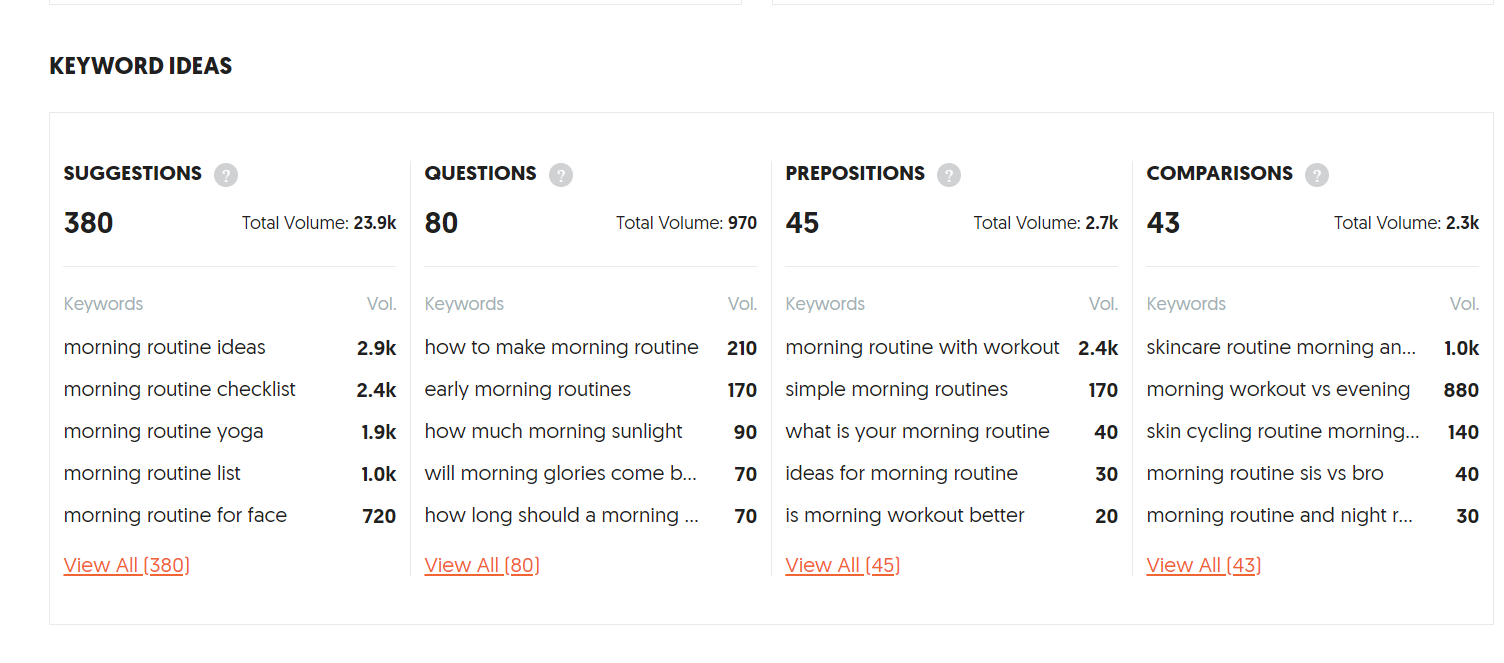
Variation 2 - “morning routine productivity”
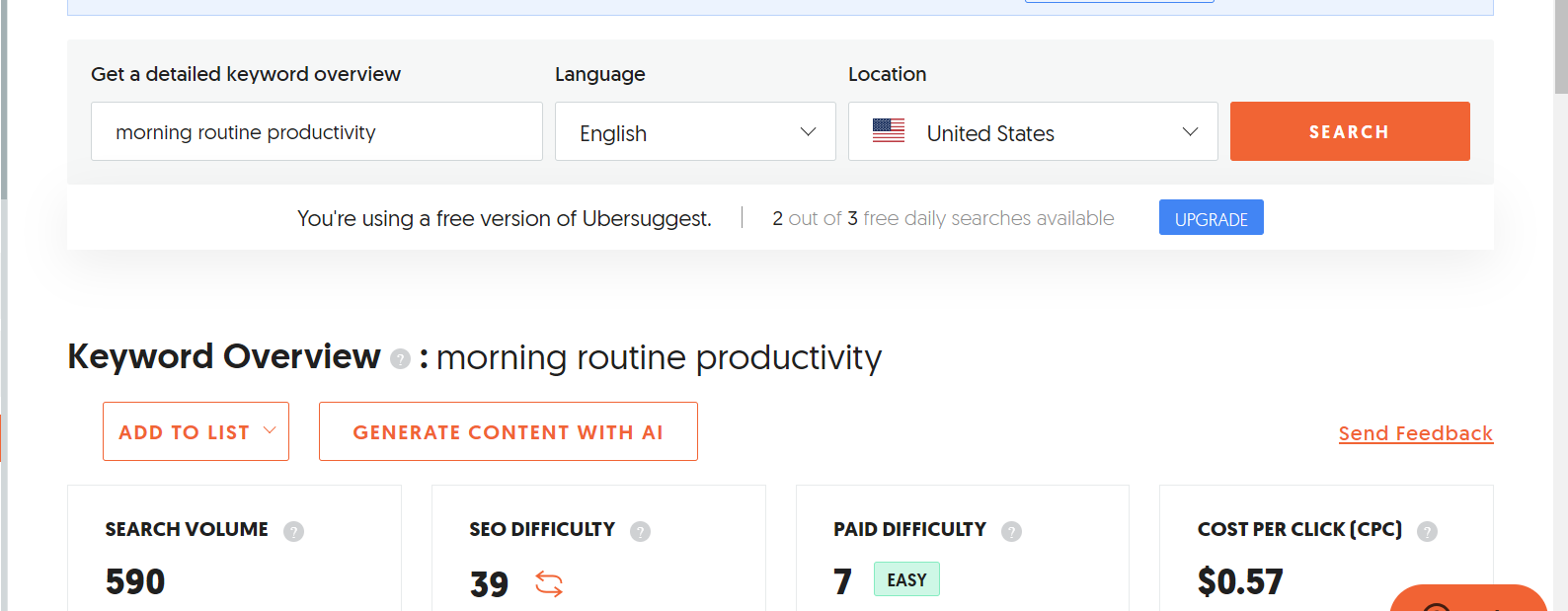
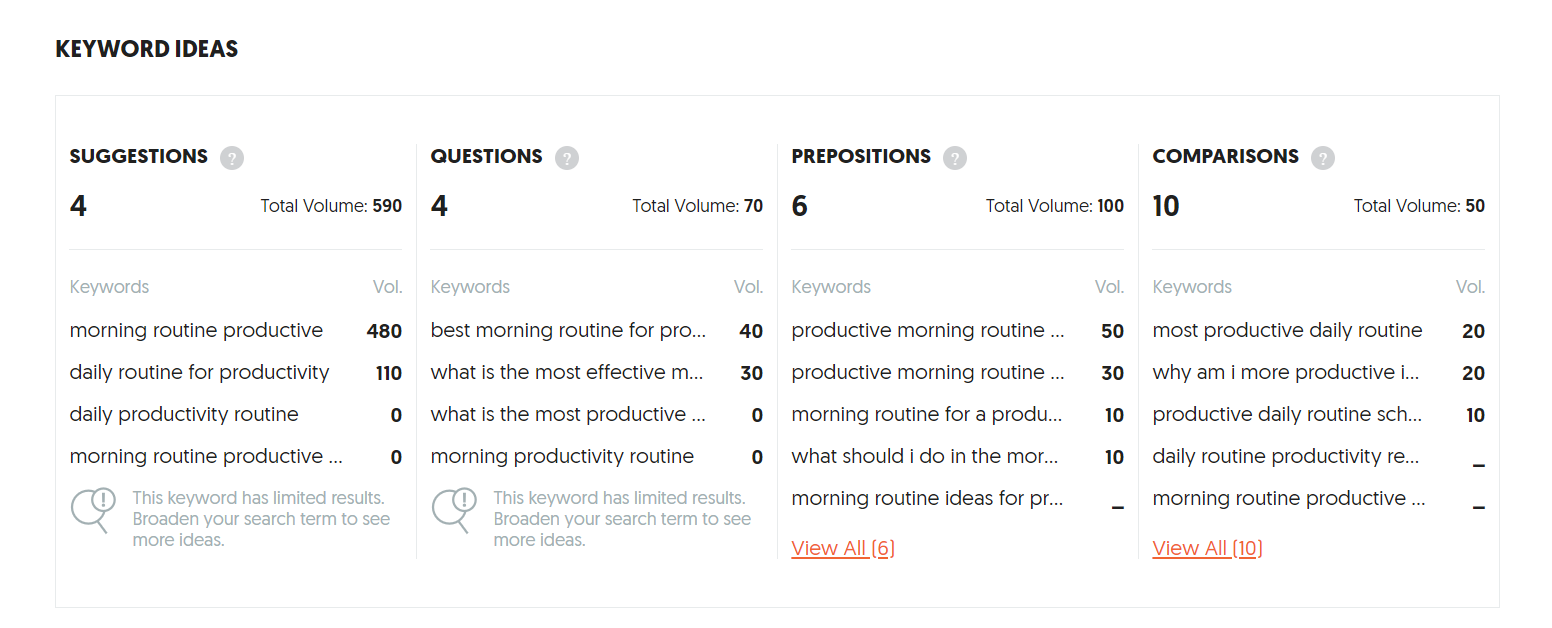
Variation 3 - “morning routine for productivity.”
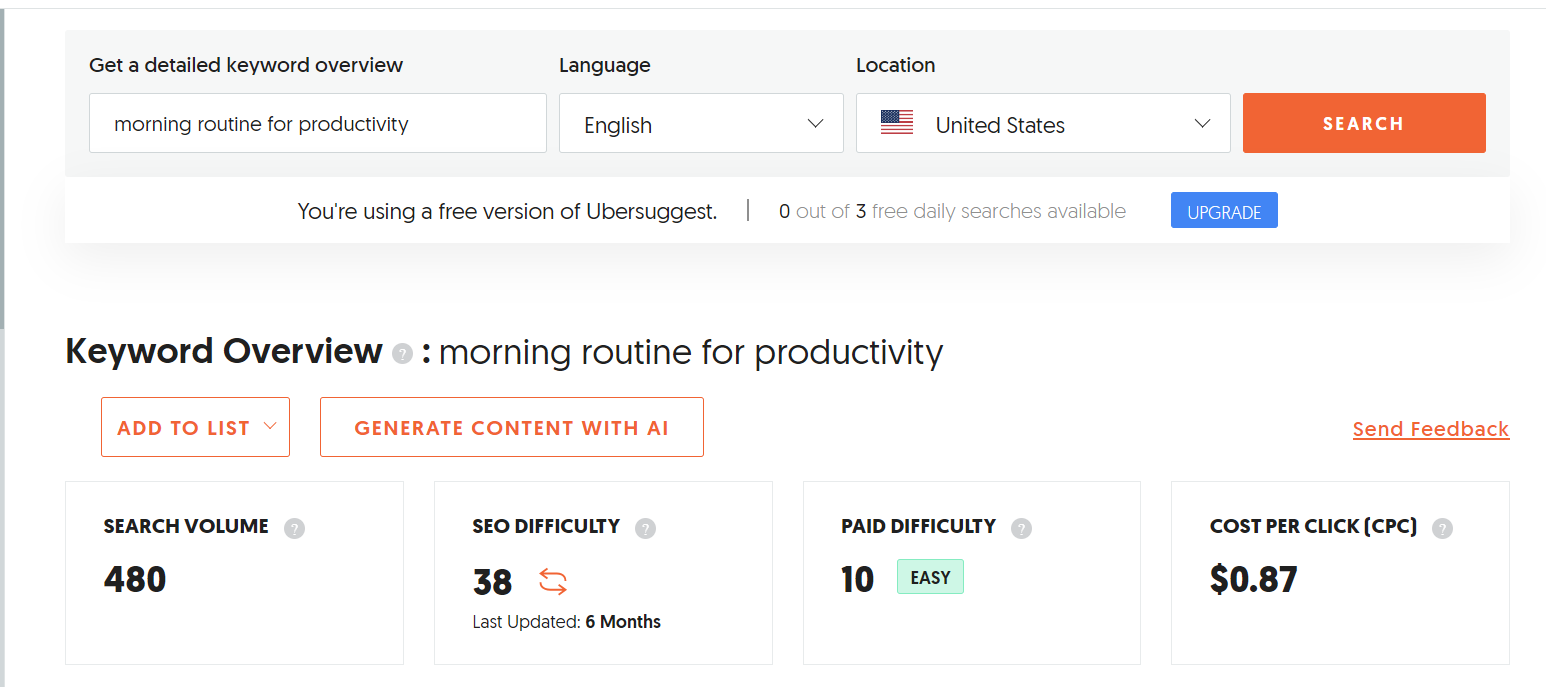
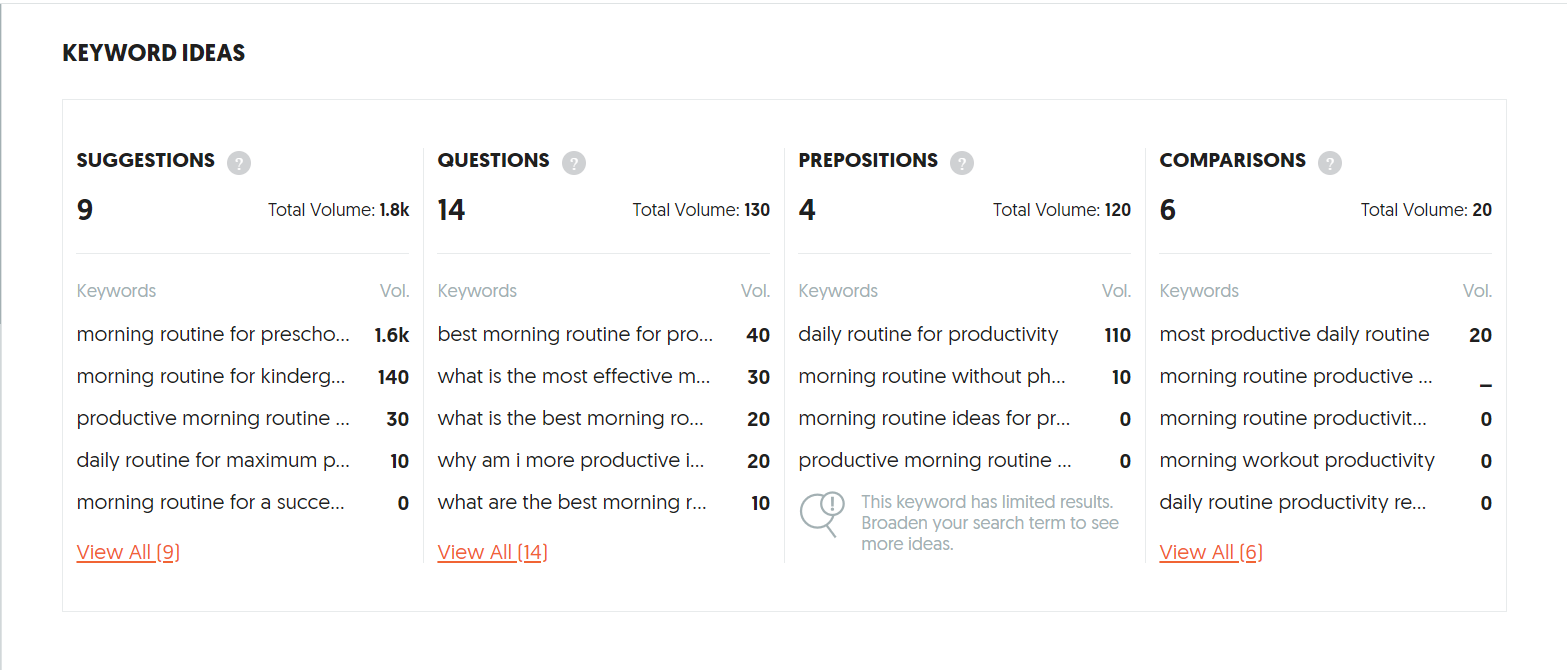
From the keyword ideas, I chose variation 2 - ”morning routine productivity.” This is because;
Note: Typically, lower search volume keywords are lower in terms of competition. I’m seeking to strike a balance between specificity, search volume, and competition here.
Having chosen the primary keyword, ”morning routine productivity,” what are my secondary keywords?
Using the Ubersuggest keyword ideas section is a good way to uncover relevant secondary keywords. In this instance, secondary keywords include:

Source: Ubersuggest
At this point, I also like to use the Google Keyword Planner to source further relevant keywords:

Source: Google Keyword Planner
Having gathered these related search queries (or secondary keywords), I now need to ensure that these secondary keywords complement the primary keyword I’ve selected.
To check this, I’ll Google my primary keyword (”morning routine productivity”) in one tab, then in a second tab I Google one of my secondary keywords. If I’m seeing either similar results, or the same results for both searches then I’ve identified a well-matched secondary keyword.
However, if the results which are returned for any of my secondary keywords are very different to those returned for my primary keyword, this means it’s not a good match. A big difference in the search results returned indicates that Google views this secondary keyword as a discrete query. As such, if we want to target this term we’ll need to create a separate piece of content.
I’ll check each of the secondary keywords in turn, and keep only the good matches (i.e. keywords where I’m seeing either the same, or very similar search results).
Here I’m looking to understand which related terms I should use to add more context. For example: Productive day, daily routines, early morning routines, a productive morning, successful individuals, morning routine for a good day, effective morning workout, wake up, focus, etc.
Paid SEO tools like Semrush, Ahrefs, Moz, etc., provide this, but some free tools may provide insights to help us make valuable decisions. One of them is the Keyword Sheeter:

Source: Keyword Sheeter
Note: Use your best judgment to select the most relevant terms during this phase.
Here I’m looking to understand which pages are ranking well for the term: “morning routine productivity”. In the screenshot below you can see the SERP.
Note: Always conduct SERP analysis based on your target audience's location. You may have to use a VPN to do this if you’re based elsewhere.
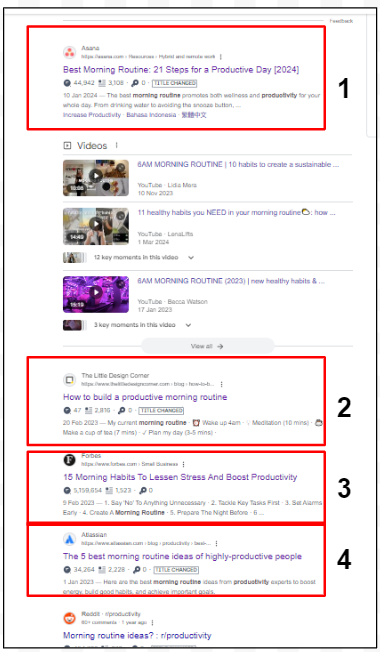
Source: Google’s SERP
Our first 4 competitors are:
I like to manually analyze each article for structure, content flow, content examples, graphics, etc, to identify gaps and determine what to include in my own content outline.
a) Use Google’s search operators: site:sitename.com “target keyword” or all in text:target keyword site:domain.com.
For example, allintext:morning routine productivity site:https://asana.com/ shows me all content with the keywords ‘morning,’ ‘productivity,’ ‘routine,’ or ‘morning routine productivity’ on Asana’s website. If I were creating this content outline for Asana this would be a great list of potential internal pages to consider linking to and from this content.
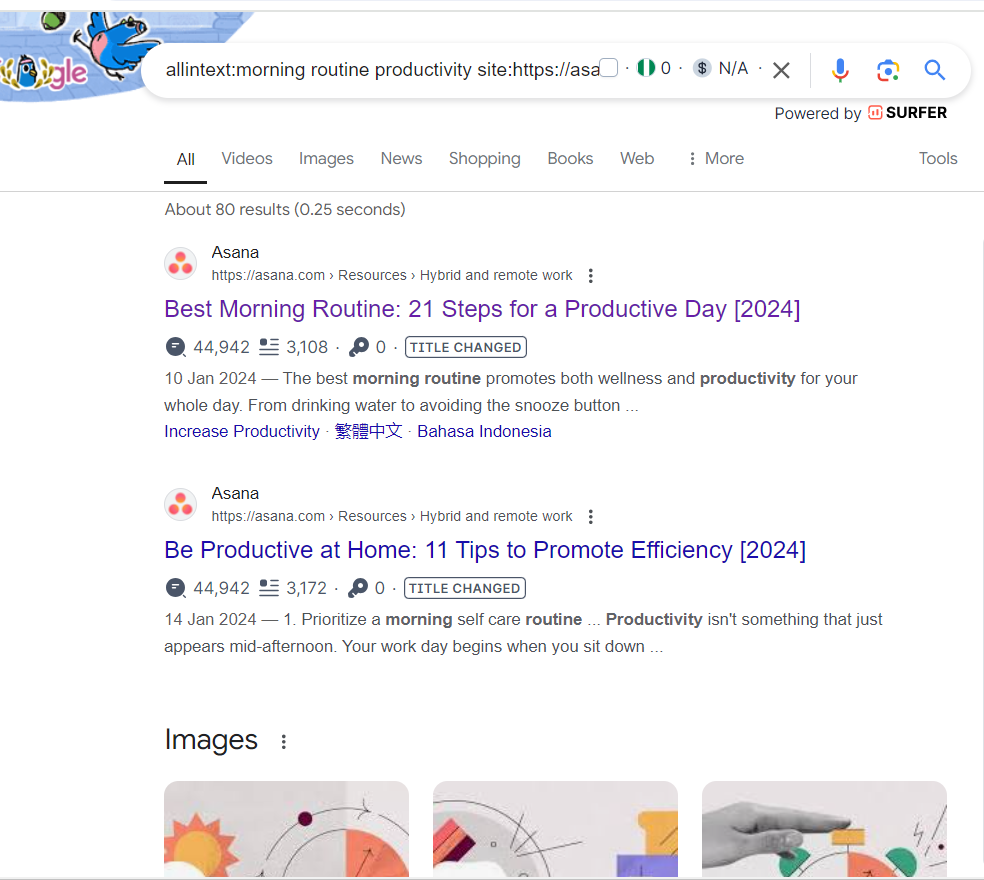
Source: Google SERPs for AsanGoogle SERPs for Asan
b) Using the website’s internal search bar: If the website you’re working on has an internal search function, this may be a good option to uncover relevant pages to link to or from.
Important things to note during internal linking include
Here are the available opportunities on Google for my target keyword: AI overview, Videos, People Also Ask, and List snippets.

SERP features for the keyword “morning routine productivity.”
Based on the screenshot above, the schema I would recommend for this topic include:
Another way to uncover this opportunity as a beginner is to spy on competitors using Google’s Schema Markup Testing Tools.
I carefully analyzed competitors for my target keyword to understand how they have used images across their pages. None of my competitors used images, but I have decided to have an infographic highlighting the topic subheading.
Now that we’ve carefully done our research, it’s time to put all elements together in an easy-to-digest format.
You may decide to use a spreadsheet or a document to present your outline. The key objective is to ensure that whoever works with the outline can achieve a smooth workflow while adhering to the brand’s tone and writing expectations. The information in the document must be clear and easy to understand.
Here’s my example content outline
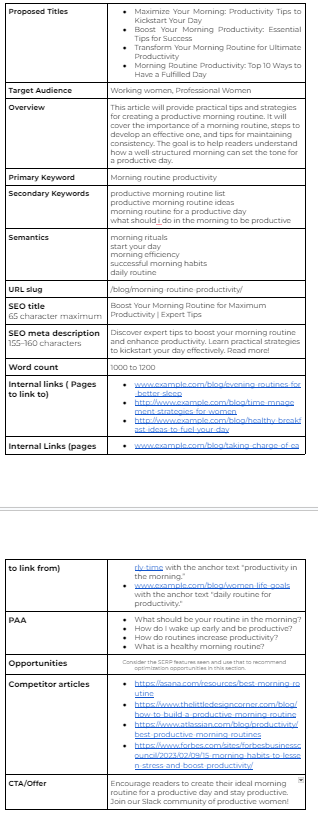
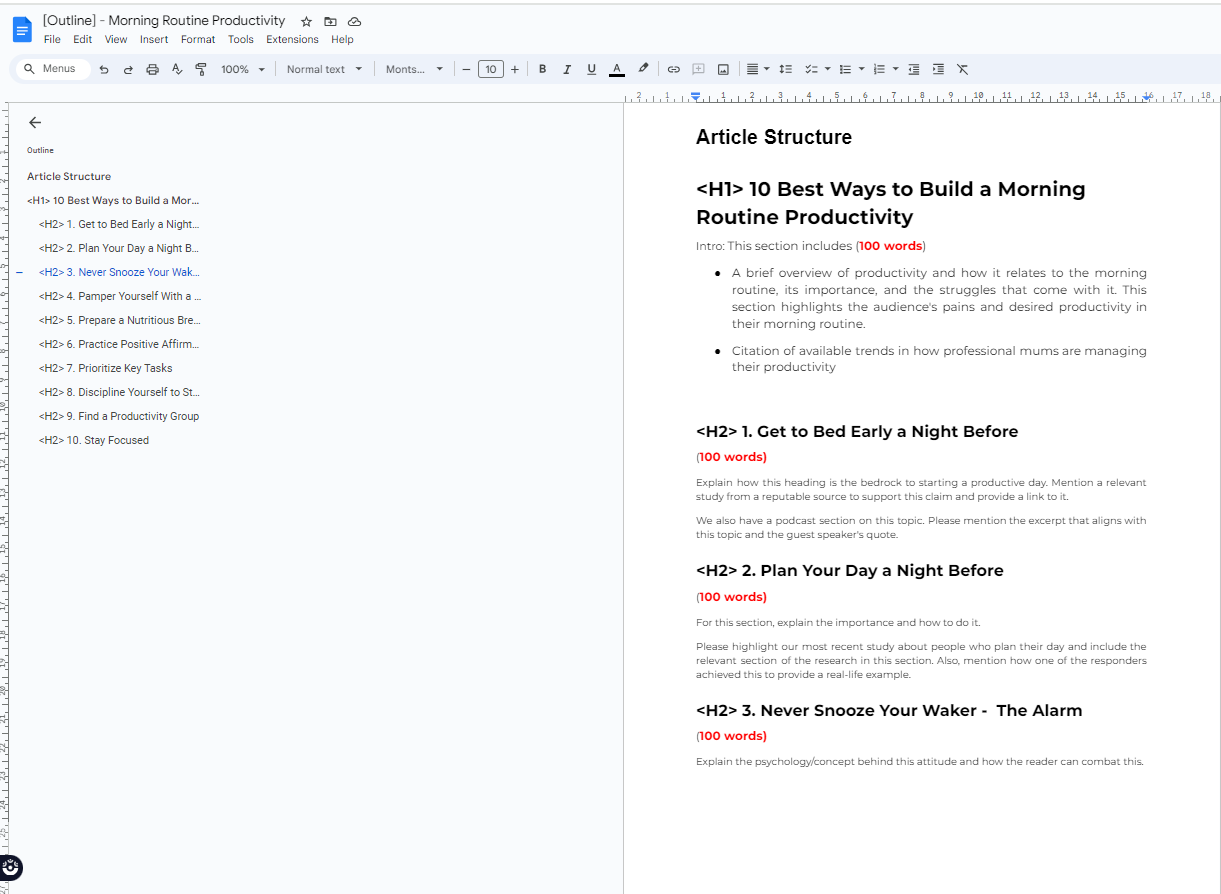
Final outlook of our example topic: How to Create a Morning Routine for Increased Productivity
You can make a copy of this to use for your next project.
Now that you’ve seen that even as a beginner, you can create a people-first outline that’s optimized for search, what's next?
Hopefully, I’ve shown that you can do all of this without paying for tool subscriptions. It’s a great way to practice and become more experienced without barriers. Plus, in the future, if you do gain access to a paid tool, you already understand the key concepts and processes to go through.
Remember: What matters is the quality of user experience you’ve been able to create and achieve with the content outline you created.
Start creating content outlines that help brands communicate value today!
Entities, topics, keywords: Clarifying core semantic SEO concepts
LEMA Framework: How to Create Remarkable Content That Drives Results